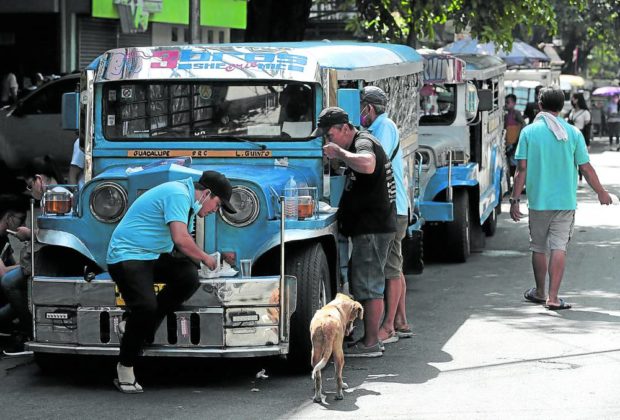
LUNCH BREAK | Jeepney drivers take a break to eat their lunch at the intersection of Agoncillo and Pedro Gil streets in Manila during the transport strike. (Photo by RICHARD A. REYES / Philippine Daily Inquirer)
MANILA, Philippines — Even as the government downplayed the impact of their mass action, some jeepney drivers and operators continued on Tuesday their weeklong strike to protest the phaseout of traditional jeepneys.
Based on the latest monitoring of the Metropolitan Manila Development Authority (MMDA), the transport situation was normal in most major routes on the second day of the strike, except for a few holdouts in several areas and some protesters at the Heritage in Baclaran, Old Terminal in Alabang, Monumento in Caloocan City and Catmon, St. Francis streets in Malabon.
In a statement, the Palace said that routes provided with Libreng Sakay (free rides) by the government on the first day of the protest were back to “normal operations” on Tuesday and there were no reports of stranded commuters.
It added that local governments in Metro Manila and different government agencies “successfully” assisted 4,794 passengers on Monday using 130 vehicles that were mobilized for the effort. But for Mar Valbuena of transport group Manibela, which initiated the mass action, the first day of the transport strike was a “success.”
‘Like a holiday’
“It was like a holiday, like Holy Week. There weren’t many people who went out and there were a lot of [contingency] plans so you couldn’t really feel it but the fact that there were not many people [on the streets] and [schools had to hold online] classes, [means] it’s a success,” he said in a radio interview on Tuesday.
Valbuena, along with Modesto Floranda of Piston, had stressed that they were not against the modernization of the transportation system but the phaseout of traditional jeepneys.
They urged the Land Transportation Franchising and Regulatory Board (LTFRB) to scrap the memorandum circular mandating the consolidation of individual jeepneys, which they said would eventually lead to the phaseout of the so-called “King of the Road.”
President Ferdinand Marcos Jr. earlier said that the public utility vehicle modernization program (PUVMP) was necessary but its implementation needed more discussions among stakeholders, particularly jeepney drivers’ groups.
He added that while he sees the need to modernize PUVs, proper program implementation was necessary.
For several jeepney drivers and operators, heeding the consolidation requirement of the PUVMP would mean giving up their franchise and jeepneys—their main source of income.
“When we lose our franchise, many fathers will lose their livelihood and in effect, our families would starve,” Buboy Ramos said.
Hector Velarde, president of the Novaliches-Malinta Jeepney Operators and Drivers Association, reminded the government that some of them had been on the road for decades, serving commuters by bringing them to their workplaces.
LTFRB technical division head Joel Bolano, however, defended the consolidation requirement, saying it would eliminate competition among individual operators.
LTFRB Chair Teofilo Guadiz III also said earlier the PUVMP’s aim was to “upgrade and rehabilitate” jeepneys instead of phasing them out.